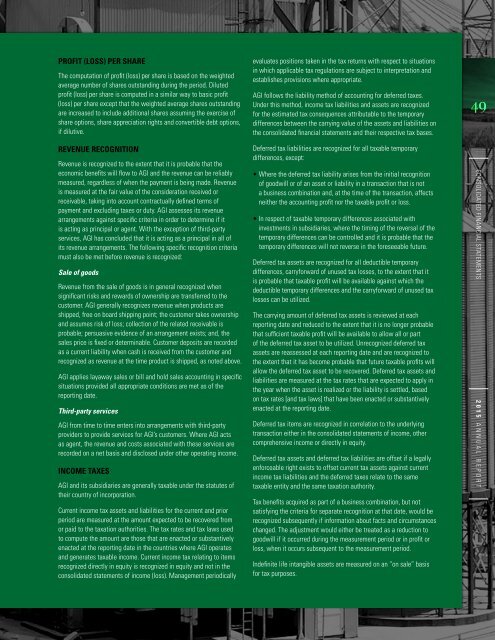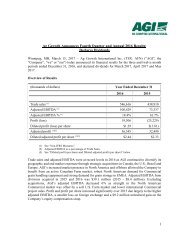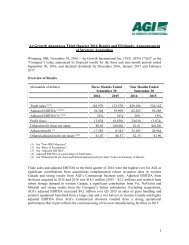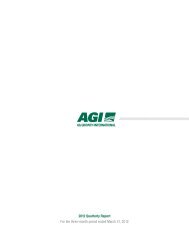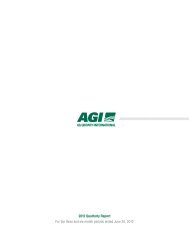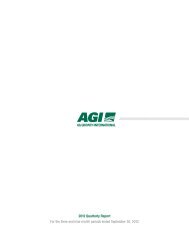Annual Report 2015
Create successful ePaper yourself
Turn your PDF publications into a flip-book with our unique Google optimized e-Paper software.
Profit (loss) per share<br />
The computation of profit (loss) per share is based on the weighted<br />
average number of shares outstanding during the period. Diluted<br />
profit (loss) per share is computed in a similar way to basic profit<br />
(loss) per share except that the weighted average shares outstanding<br />
are increased to include additional shares assuming the exercise of<br />
share options, share appreciation rights and convertible debt options,<br />
if dilutive.<br />
evaluates positions taken in the tax returns with respect to situations<br />
in which applicable tax regulations are subject to interpretation and<br />
establishes provisions where appropriate.<br />
AGI follows the liability method of accounting for deferred taxes.<br />
Under this method, income tax liabilities and assets are recognized<br />
for the estimated tax consequences attributable to the temporary<br />
differences between the carrying value of the assets and liabilities on<br />
the consolidated financial statements and their respective tax bases.<br />
49<br />
Revenue recognition<br />
Revenue is recognized to the extent that it is probable that the<br />
economic benefits will flow to AGI and the revenue can be reliably<br />
measured, regardless of when the payment is being made. Revenue<br />
is measured at the fair value of the consideration received or<br />
receivable, taking into account contractually defined terms of<br />
payment and excluding taxes or duty. AGI assesses its revenue<br />
arrangements against specific criteria in order to determine if it<br />
is acting as principal or agent. With the exception of third-party<br />
services, AGI has concluded that it is acting as a principal in all of<br />
its revenue arrangements. The following specific recognition criteria<br />
must also be met before revenue is recognized:<br />
Sale of goods<br />
Revenue from the sale of goods is in general recognized when<br />
significant risks and rewards of ownership are transferred to the<br />
customer. AGI generally recognizes revenue when products are<br />
shipped, free on board shipping point; the customer takes ownership<br />
and assumes risk of loss; collection of the related receivable is<br />
probable; persuasive evidence of an arrangement exists; and, the<br />
sales price is fixed or determinable. Customer deposits are recorded<br />
as a current liability when cash is received from the customer and<br />
recognized as revenue at the time product is shipped, as noted above.<br />
AGI applies layaway sales or bill and hold sales accounting in specific<br />
situations provided all appropriate conditions are met as of the<br />
reporting date.<br />
Third-party services<br />
AGI from time to time enters into arrangements with third-party<br />
providers to provide services for AGI’s customers. Where AGI acts<br />
as agent, the revenue and costs associated with these services are<br />
recorded on a net basis and disclosed under other operating income.<br />
Income taxes<br />
AGI and its subsidiaries are generally taxable under the statutes of<br />
their country of incorporation.<br />
Current income tax assets and liabilities for the current and prior<br />
period are measured at the amount expected to be recovered from<br />
or paid to the taxation authorities. The tax rates and tax laws used<br />
to compute the amount are those that are enacted or substantively<br />
enacted at the reporting date in the countries where AGI operates<br />
and generates taxable income. Current income tax relating to items<br />
recognized directly in equity is recognized in equity and not in the<br />
consolidated statements of income (loss). Management periodically<br />
Deferred tax liabilities are recognized for all taxable temporary<br />
differences, except:<br />
• Where the deferred tax liability arises from the initial recognition<br />
of goodwill or of an asset or liability in a transaction that is not<br />
a business combination and, at the time of the transaction, affects<br />
neither the accounting profit nor the taxable profit or loss.<br />
• In respect of taxable temporary differences associated with<br />
investments in subsidiaries, where the timing of the reversal of the<br />
temporary differences can be controlled and it is probable that the<br />
temporary differences will not reverse in the foreseeable future.<br />
Deferred tax assets are recognized for all deductible temporary<br />
differences, carryforward of unused tax losses, to the extent that it<br />
is probable that taxable profit will be available against which the<br />
deductible temporary differences and the carryforward of unused tax<br />
losses can be utilized.<br />
The carrying amount of deferred tax assets is reviewed at each<br />
reporting date and reduced to the extent that it is no longer probable<br />
that sufficient taxable profit will be available to allow all or part<br />
of the deferred tax asset to be utilized. Unrecognized deferred tax<br />
assets are reassessed at each reporting date and are recognized to<br />
the extent that it has become probable that future taxable profits will<br />
allow the deferred tax asset to be recovered. Deferred tax assets and<br />
liabilities are measured at the tax rates that are expected to apply in<br />
the year when the asset is realized or the liability is settled, based<br />
on tax rates [and tax laws] that have been enacted or substantively<br />
enacted at the reporting date.<br />
Deferred tax items are recognized in correlation to the underlying<br />
transaction either in the consolidated statements of income, other<br />
comprehensive income or directly in equity.<br />
Deferred tax assets and deferred tax liabilities are offset if a legally<br />
enforceable right exists to offset current tax assets against current<br />
income tax liabilities and the deferred taxes relate to the same<br />
taxable entity and the same taxation authority.<br />
Tax benefits acquired as part of a business combination, but not<br />
satisfying the criteria for separate recognition at that date, would be<br />
recognized subsequently if information about facts and circumstances<br />
changed. The adjustment would either be treated as a reduction to<br />
goodwill if it occurred during the measurement period or in profit or<br />
loss, when it occurs subsequent to the measurement period.<br />
Indefinite life intangible assets are measured on an “on sale” basis<br />
for tax purposes.<br />
CONSOLIDATED FINANCIAL STATEMENTS <strong>2015</strong> ANNUAL REPORT


